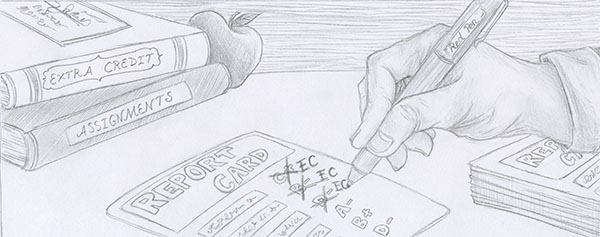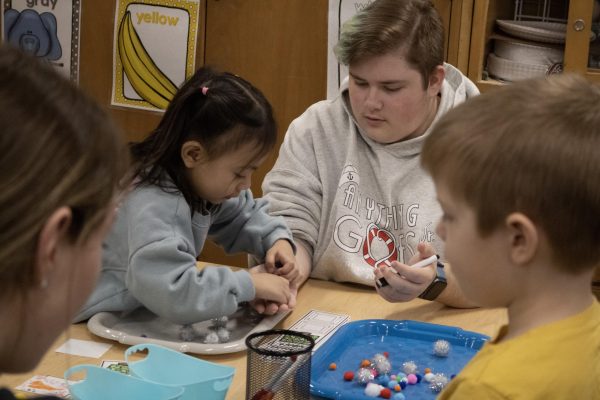Extra credit policies vary across school

Illustration by Jini John
November 6, 2015
Extra credit, whether it is used as a tool to further knowledge of course curriculum or just as a little boost, can determine the difference between an A or a B. Extra credit is an aspect of course policy, which can in turn affect students in the classroom.
Extra credit policies vary, because they lie within the discretion of the teacher in both the content of the extra credit offered and in what form. English teacher Annie Chiado explained how although she believes that extra credit work, from her perspective, is not as valuable as work implemented within the class, she offers a policy to her students where they can come to her at any time seeking to complete an extra credit assignment.
“I believe in the word extra, when you’re talking about extra credit,” Chiado said. “If I am going to give an extra credit opportunity, I want to see that the learning opportunities that I’ve created thus far have been taken advantage of… [Extra credit] opportunities aren’t as valuable to me as a teacher, as a learner, as a grader, as [the assignments] that I have built into the course for [all students].”
In comparison to Chiado’s beliefs on the value of built in course assignments, sophomore Arij Virani believes that extra credit is unfair because it is an addition to completing the required homework. Virani explained that for her, extra credit just builds more stress and brings unnecessary pressure.
“I just disagree with extra credit in general,” Virani said. “[Extra credit] is similar to doing that extra homework, on top of the homework that you already have to do. Plus you have so many other classes…I think the pressure [of completing extra credit] is also another big thing. If I don’t complete it and everyone else does, then I’ll be the one that is missing out, but if I do complete it then I might not be able to finish something that’s actually due.”
Junior Dhanya Thomas explained that for her, she favors extra credit, specifically extra projects or out of class assignments. However, Thomas said she views extra credit test questions offered as a negative. Thomas noted those questions force her to view the test she is taking differently, focusing on the extra credit questions instead of the content on the test.
“I prefer actually doing [an extra credit assignment] outside [of class time] versus doing extra credit on paper, mainly because if I find extra credit on a test I’m just so prone to think mostly about the extra credit, trying to get that right instead of actually worrying about the test itself,” Thomas said.
Junior Danielle Callas explained that for her, completing assignments that require out of class attendance is not always possible due to after school activities. Callas explained how in her US History 163 class, an assignment was offered to attend a movie pertaining to in-class curriculum. For students unable to attend, an alternate reading assignment was offered, allowing others to have the opportunity to do extra credit.
“I think that it’s better that [teachers] offer any chance for each person to have an extra credit opportunity, because then it allows everyone to participate [in receiving extra credit],” Callas said.
According to Rosemarie Carsello, American Sign Language (ASL) and Spanish world language teacher, offering extra credit opportunities to her students prior to oral presentations or assessments is a good idea. Carsello explained how she will offer extra credit to students that go to the TLC to practice their presentation, in hopes that this will overall benefit the student in their speaking skills.
“[The purpose of going] wouldn’t necessarily be for a presentation, but it may be in preparation for some kind of assessment, like additional practice for an assignment that is coming up,” Carsello said. “[Students] can use this opportunity in context [to the class]…I would hope that [students] find the experiences of being able to go to the TLC beneficial because they’re probably learning from someone who is at a level above them, so hopefully it’s a real learning experience.”
Additionally, Carsello explained how she, as well as all ASL teachers, offer a required assignment for students to attend an event in the deaf community. According to Carsello, ASL 163 and 263 students are required to attend one event a semester, and ASL 363 and 463 students are required to attend two events, but students who attend more than what is required will receive extra credit. Carsello explained her reasoning behind offering this assignment, and how she feels it benefits students.
“As far as going to a community event I have never got a negative response back [from a student]… so going to [community events] have been very positive, and encouraging [for students],” Carsello said. “If [students] go to events outside of school, it’s an experience they would never be able to have in the classroom, because I can only try to recreate a deaf environment in the classroom.”
In addition to extra credit test questions and project opportunities, sophomore Tess Flores explained how she has been offered non-academic extra credit assignments, such as bringing in Post-It notes or tissue boxes to her English class. According to Flores, the extra credit opportunities that have been offered this year have not been academically related to the class curriculum.
“Most of the extra credit assignments I’ve gotten haven’t been related to the curriculum, or to anything we have been learning [in class],” Flores said. “[The assignments] would just make you go out and spend a couple bucks for a better grade…I think that if there are going to be extra credit opportunities offered they should be related to what we are learning about in that class.”
Katie Hoover, sophomore English teacher, expressed her views on the aforementioned extra credit assignment, and explained that although the tissue boxes and Post-It notes were not directly academically related, as the year progresses, the supplies will benefit the entire class. Additionally, Hoover noted that the opportunity of bringing in supplies did not have a significant point value that impacted the overall class grade.
“The extra credit that was given for bringing in a box of tissues or the post it notes was very minimal, it [was worth] two points,” Hoover said. “The post it notes are something that we use for academic purpose. We make comments on them, we demonstrate our learning, and respond to other students’ comments, so it is benefitting the students who are bringing [supplies] in their academic life.”
In comparison to how Flores feels about the importance of connecting extra credit opportunities to curriculum, Michael Sinde, “Project Lead The Way” (PLTW) engineering teacher, implements a policy that does just that. Sinde explained that the extra credit policy that he offers is unified throughout all levels, and the courses that he teaches, all being a stand alone opportunity for students to complete a “Science, Technology, Engineering and Math” (STEM) related project outside of class, spanning throughout the entire year.
“Extra credit for me has to be done outside of the traditional class,” Sinde said. “It may not be something that is specifically tied to exactly what we are doing in the class, but something in addition to it…[The extra credit] either has to be to science, math, technology or engineering related…For example, last year a student coded a game. It’s not something we taught in the class he had, but it was definitely above and beyond the regular curriculum, so I gave him extra credit for that.”
Chiado additionally explained that contrary to how students feel about completing extra credit work, teachers primarily look for the work assigned in class.
“I know there’s something glamorous about extra credit; it feels like you’re doing extra work, but it’s not the extra work the teachers are necessarily looking for, it’s the assigned work,” Chiado said.











